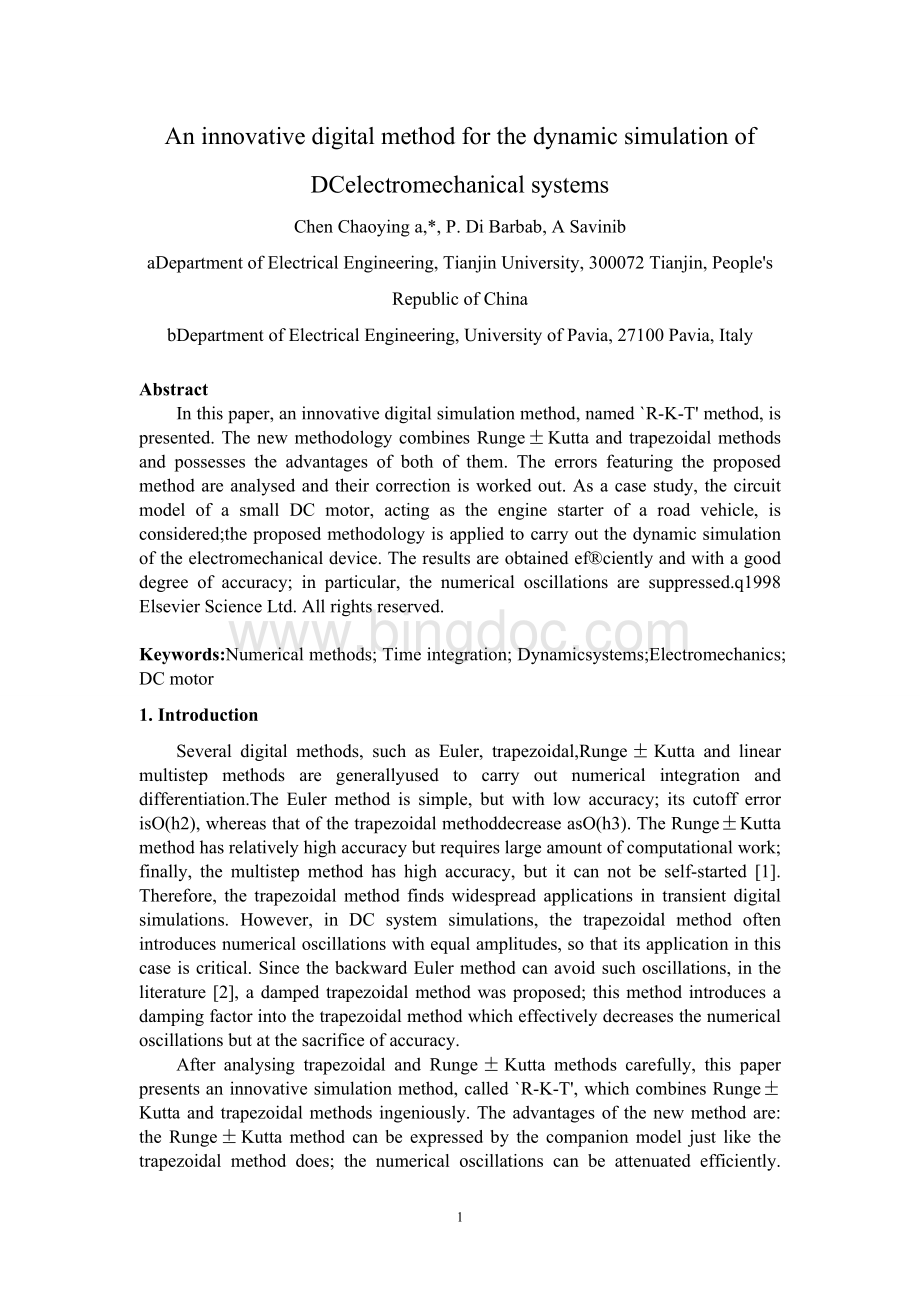机电一体化英文论文.doc
《机电一体化英文论文.doc》由会员分享,可在线阅读,更多相关《机电一体化英文论文.doc(20页珍藏版)》请在冰点文库上搜索。

AninnovativedigitalmethodforthedynamicsimulationofDCelectromechanicalsystems
ChenChaoyinga,*,P.DiBarbab,ASavinib
aDepartmentofElectricalEngineering,TianjinUniversity,300072Tianjin,People'sRepublicofChina
bDepartmentofElectricalEngineering,UniversityofPavia,27100Pavia,Italy
Abstract
Inthispaper,aninnovativedigitalsimulationmethod,named`R-K-T'method,ispresented.ThenewmethodologycombinesRunge±Kuttaandtrapezoidalmethodsandpossessestheadvantagesofbothofthem.Theerrorsfeaturingtheproposedmethodareanalysedandtheircorrectionisworkedout.Asacasestudy,thecircuitmodelofasmallDCmotor,actingastheenginestarterofaroadvehicle,isconsidered;theproposedmethodologyisappliedtocarryoutthedynamicsimulationoftheelectromechanicaldevice.Theresultsareobtainedef®cientlyandwithagooddegreeofaccuracy;inparticular,thenumericaloscillationsaresuppressed.q1998ElsevierScienceLtd.Allrightsreserved.
Keywords:
Numericalmethods;Timeintegration;Dynamicsystems;Electromechanics;DCmotor
1.Introduction
Severaldigitalmethods,suchasEuler,trapezoidal,Runge±Kuttaandlinearmultistepmethodsaregenerallyusedtocarryoutnumericalintegrationanddifferentiation.TheEulermethodissimple,butwithlowaccuracy;itscutofferrorisO(h2),whereasthatofthetrapezoidalmethoddecreaseasO(h3).TheRunge±Kuttamethodhasrelativelyhighaccuracybutrequireslargeamountofcomputationalwork;finally,themultistepmethodhashighaccuracy,butitcannotbeself-started[1].Therefore,thetrapezoidalmethodfindswidespreadapplicationsintransientdigitalsimulations.However,inDCsystemsimulations,thetrapezoidalmethodoftenintroducesnumericaloscillationswithequalamplitudes,sothatitsapplicationinthiscaseiscritical.SincethebackwardEulermethodcanavoidsuchoscillations,intheliterature[2],adampedtrapezoidalmethodwasproposed;thismethodintroducesadampingfactorintothetrapezoidalmethodwhicheffectivelydecreasesthenumericaloscillationsbutatthesacrificeofaccuracy.
AfteranalysingtrapezoidalandRunge±Kuttamethodscarefully,thispaperpresentsaninnovativesimulationmethod,called`R-K-T',whichcombinesRunge±Kuttaandtrapezoidalmethodsingeniously.Theadvantagesofthenewmethodare:
theRunge±Kuttamethodcanbeexpressedbythecompanionmodeljustlikethetrapezoidalmethoddoes;thenumericaloscillationscanbeattenuatedefficiently.Accordingtofrequencyspectrumanalysis,theerrorsofthemethodarecalculatedandcorrected.ItmakesitpossibletosimulateDCsystemsaccuratelyandefficiently.
2.NumericaloscillationsoftrapezoidalmethodinDCsystems
ConsideringtheinductivecircuitshowninFig.1(a)thegoverningequationis
wherecurrentiistheunknown.Usingthetrapezoidalmethodfortimeintegration,onecanget:
Wherehisthetimestepofcalculation.
Let
then
ThecompanionmodelofthatdepictedinFig.1(a)isshowninFig.1(b).FromEq.
(1)onecanalsoget:
Fig.1.Inductiveimpedance(a)anditscompanionmodels(b)and(c).
where
ItscompanionmodelisshowninFig.1(c).
Suppose,whenaDCcurrent¯owsthroughtheinductiveimpedance.FromEq.(3)thevoltageresponseoftheinductivebranchcanbecalculatedas
Itcanbeseenthattheoscillationofvoltageisundepressed.
Otherwiseassume,whennk,thecurrentisswitchedoff,i.e.fromEq.(3)onecanget:
thatis
Thevoltageresponseisalsoanundepressedoscillation.
ItcanbeprovedthatthebackwardEulermethodcanavoidsuchanoscillation.Forinductiveimpedanceitgives:
Itcanbeseenthatun11isnotdependentonun,sothismakesitpossibletoavoidnumericaloscillationsbutgreatlyreducestheaccuracyofbackwardEulermethod.Tosolvethiscontradiction,theliterature[2]proposesatrapezoidalmethodwithdamping.Forthedifferentialequation
itgives
FortheinductiveimpedanceshowninFig.1itgives:
Whereaisthedampingfactor(0Thismethodturnsintothetrapezoidalonewhena=0,andbecomesthebackwardEulermethodwhena=1.FromEq.(9),itcanbeseenthatthecoeficientofunissowhenthevoltageoscillationisproduced,itcanbedampedoutquickly.Thebiggerthefactoris,themorequicklytheoscillationisreducedandtheloweraccuracycanbeobtainedbythismethod.Besides,thefactorcanbeselectedonlyaccordingtoexperience:
itsoptimumvalueisdif®culttobedetermined.
3.TheR-K-Tmethod
TheRunge±KuttamethodhashigheraccuracyandbetterstabilityinDCsystems,butitrequiresthecalculationofthevaluesofafunctionmanytimesduringasinglestep;itcannotbeexpressedbyacompanionmodellikethetrapezoidalmethod.IfonecancombinetheRunge±Kuttamethodandthetrapezoidalmethodtoformanewmethod,thenitwillpossesstheadvantagesofbothtwomethods.Takethe3rdorderRunge±Kuttamethodforexample,todeducethenewmethod.Forthedifferentialequation
bythe3rdorderRunge±Kuttamethod,onehas[3]
Fortheinductiveimpedance,onehas:
where
FromEq.(10)itfollows
Whereisthevoltageatthemidpointofthestep,whichcanbefoundbysolvingtheequationsofthesystem.Butwecalculateitbytrapezoidalmethod.Itcanbedoneintwodifferentways(A)and(B):
(A)Taketheaveragevaluesofunandun11andlet
Substitutingun11/2fromEq.(14)intoEq.(13)Eq.(10)gives:
SubstitutingtheaboveformulaintoEq.(10),onecanget:
where
Itisobviousthatthe3rdorderRunge±Kuttamethodwithun11/2substitutedbyEq.(14)maybeexpressedbythecompanionmodelshowninFig.1(b),asforthetrapezoidalmethod;theparametersofthemodelare:
Thedistinguishingfeatureofthismethodisthatthecoef®-cientsofun11andunarenotequal;theirratioAmaybeusedtoattenuatethenumericaloscillationwithequalamplitudesoftrapezoidalmethod.ItturnstothetrapezoidalmethodwhenR=0,i.e.theformulaforpureinductancegivenbytrapezoidalmethod:
(B)Take
Usingthetrapezoidalmethod,onehas:
BysubstitutingEq.(19)intoeq,(13),onecanget:
BysubstitutingtheaboveequationsintoEq.(10),itfollows
Where
Formula(20)maybeexpressedbyacompanionmodelofinductiveimpedanceasFig.1(b),where
Formula(20)hasalsothefunctionofattenuatingthenumericaloscillationslikeEq.(15),anditalsoturnstothetrapezoidalmethodforpureinductancewhenR=0.
Forthe4thorderRunge±Kuttamethod,itgives:
Similarlyonecanobtainthecompanionmodelforthe4thorderRunge±Kuttamethodasfollows[4].
(A)Takingonehas:
Where
ItscompanionmodelinFig.1(b)is
(B)Takingonecanget
where
ItscompanionmodelforFig.1(b)is:
Bothofthe4thordermodelsintroducedabovealsoturntotrapezoidalmethodforpureinductancewhenR0.Thus,theRunge±Kuttamethodiscombinedwithtrapezoidalmethodtoformanew`R-K-T'method,whichexhibitstheadvantagesofthesetwomethods.
4.AnalysisandcalculationoferrorfortheR-K-Tmethod
Inareal-lifesystem,voltagesandcurrents,whateverwaveformstheymayhave,canbeanalyzedbythemethodoffrequencyspectrum.Theerrorofsimulationcanbeanalyzedforeveryfrequencycomponent;thecomponentsarethenaddedtogetheraccordingtothetheoryofsuperpositiontoobtainthetotalerrors.
Letusassumethatcurrentandvoltageofacertainsystemelementare:
Wherewanyonefrequencycomponent.Letusrewritethe3rdR-K-Tmethod(20)asfollows:
SubstitutingEq.(27)intoEq.(28),onecandeduce:
Fromtheformulaofinductiveimpedance,onehas
ThedifferenceofthetwosidesofEq.(29)representstheerrorofR-K-Tmethodforfrequencycomponent,sothattheerrorfunctioncanbede®nedas:
Iftheexcitingsourcescontainanumberoffrequencycomponents,e(v)shouldbecomputedforeveryfrequencycomponentandaddedtogether.Thesummationofallthee(v)givesthetotalerrorfunctionofthe3rdorderR-K-Tmethod.
5.CorrectionoferrorfortheR-K-Tmethod
FromEq.(29)itisclearthatthereisunbalanceintheformulaoftheR-K-Tmethodforangularfrequency;itisduetothemethoditselfandnotrelatedtotheexcitingsources.IfonewouldmatchthetwosidesofEq.(29)byaddingsomeitems,thenitcouldgivetheaccurateresultforfrequencycomponent.Letv0bethemainangularfrequencyoftheexcitingsource,inordertoconductaccuratecalculationforv0,itisnecessarytotransformEq.(29)asfollows:
ThecoeficientsofthetwosidesofEq.(32)areequalw=w0.Itmeansthatitgivesaccurateresultsforw=w0.
RestoringEq.(32),onecandeduce:
where
Eq.(33)istheformulaoftheR-K-Tmethodaftercorrection.Iftheexcitingsourceofthesystemhasasinglefrequencyv0,thencorrectioncanbemadeforthisfrequency.Ifthesystemhasamultifrequencyexcitingsource,thencorrectionmaybemadeforoneofthedominantlowerfrequencywhichhashigheramplitude.
6.Numericalresults
Tochecktheaccuracyofthemethodpresented,thecircuitshowninFig.2hasbeenconsidered.Itsparametersare:
Theaccurateexpressionofcurrentiis:
ThetestcircuitshowninFig.2hasbeensolvedbyeachofthemodelsstatedabovewithtimesteph=0.1ms,aswellasbymeansofformula(34)givingamoreaccurateresult.Ineachcaseerrorisdefinedasthemaximumabsolute
Fig.3.Errorcurvesforeachmodel(T:
cycle)(seeTable1).
Fig.4.Errorcurvesforeachmodel(T:
cycle)(seeTable1).
Fig.5.Errorcurvesforeachmodel(T:
cycle)(seeTable1).
Fig.6.Errorcurvesforeachmodel(T:
cycle)(seeTable1).
Fig.7.Errorcurvesforeachmodel(T:
cycle)(seeTable1).
Fi